|
Combat Skills of
the Soldier
FM 21-75
HEADQUARTERS
DEPARTMENT OF THE ARMY
Washington, DC,
3 August 1984
APPENDIX C
Obstacles
In combat, enemy units use obstacles to stop or slow their opponent's
movement. Because of that, you may have to bypass or breach (make a gap through)
those obstacles in order to continue your mission.
Two basic obstacles used by the enemy are minefield and wire obstacles. This
appendix gives guidance on breaching and crossing minefield and wire obstacles.
HOW TO BREACH AND CROSS A MINEFIELD
There are many ways to breach a minefield. One way is to probe for and mark
mines to clear a footpath through the minefield.
PROBING FOR MINES
-
Remove your helmet, load-carrying equipment (LCE), watch, rings, belt, dog
tags, and anything else that may hinder movement or fall off.
-
Leave your rifle and equipment with another soldier in the team.
-
Get a wooden stick about 30 cm (12 in) long for a probe and sharpen one of
the ends. Do not use a metal probe.
-
Place the unsharpened end of the probe in the palm of one hand with your
fingers extended and your thumb holding the probe.
-
Probe every 5 cm (2 in) across a l-meter front. Push the probe gently into
the ground at an angle less than 45 degrees.
-
Kneel (or lie down) and feel upward and forward with your free hand to
find tripwires and pressure prongs before starting to probe.
-
Put just enough pressure on the probe to sink it slowly into the ground.
If the probe does not go into the ground, pick or chip the dirt away with the
probe and remove it by hand.
-
Stop probing when a solid object is touched.
-
Remove enough dirt from around the object to find out what it is.
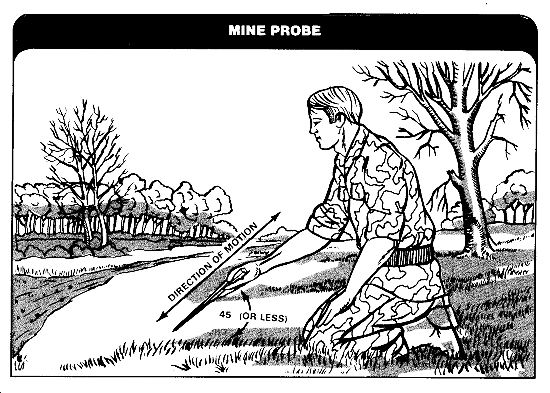
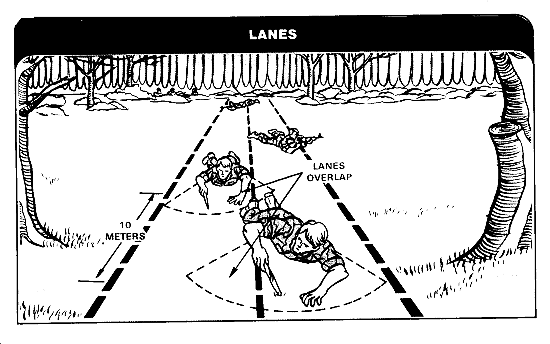
MARKING THE MINE
-
Remove enough dirt from around it to see what type of mine it is.
-
Mark it and report its exact location to your leader. There are several
ways to mark a mine. How it is marked is not as important as having everyone
understand the marking. A common way to mark a mine is to tie a piece of
paper, cloth, or engineer tape to a stake and put the stake in the ground by
the mine.
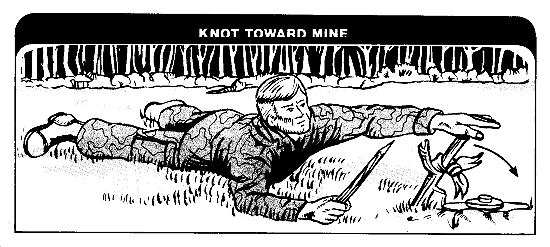
CROSSING THE MINEFIELD
Once a footpath has been probed and the mines marked, a security team should
cross the minefield to secure the far side. After the far side is secure, the
rest of the unit should cross.
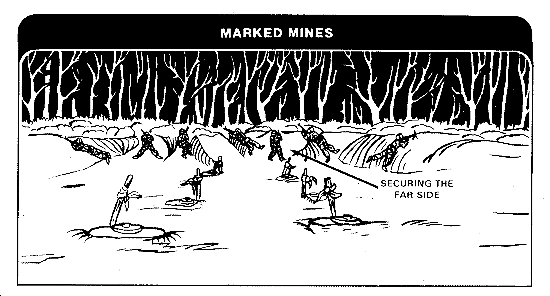
HOW TO BREACH AND CROSS WIRE OBSTACLES
The enemy uses wire obstacles to separate infantry from tanks and to slow or
stop infantry. His wire obstacles are similar to ours. To breach them, you
should use wire cutters and bangalore torpedoes.
Breaching a wire obstacle may require stealth; for example, when done by a
patrol. It may not require stealth during an attack. Breaches requiring stealth
are normally done with wire cutters. Other breaches are normally done with
bangalore torpedoes and wire cutters.
CUTTING THE WIRE
To cut through a wire obstacle with stealth:
-
Cut only the lower strands and leave the top strand in place. That makes
it less likely that the enemy will discover the gap.
-
Cut the wire near a picket. To reduce the noise of a cut, have another
soldier wrap cloth around the wire and hold the wire with both hands. Cut part
of the way through the wire between the other soldier's hands and have him
bend the wire back and forth until it breaks. If you are alone, wrap cloth
around the wire near a picket, partially cut the wire, and then bend and break
the wire.
To breach an obstacle made of concertina:
-
Cut the wire and stake it back to keep the breach open.
-
Stake the wire back far enough to allow room to crawl through or under the
obstacle.
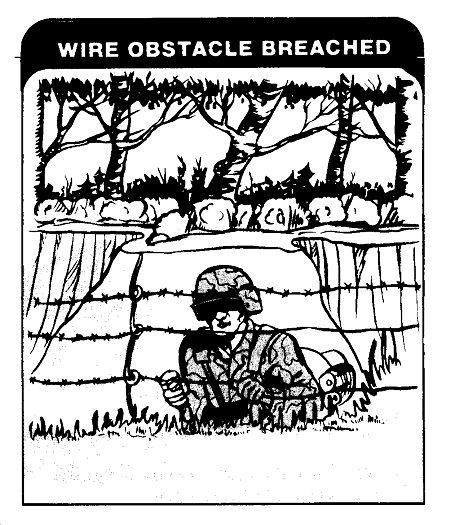
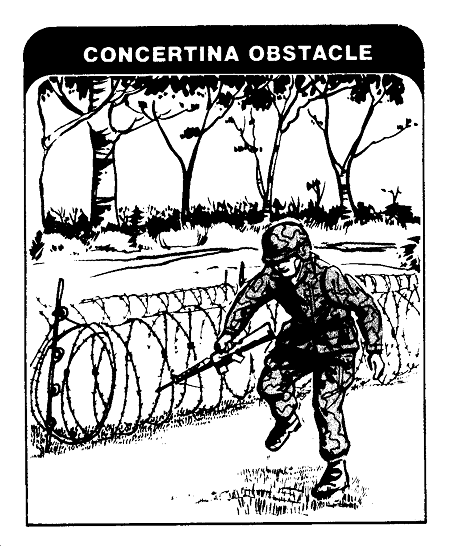
CROSSING THE WIRE
To crawl under a wire obstacle:
-
Slide headfirst on your back.
-
Push forward with your heels.
-
Carry your weapon lengthwise on your body and steady it with one hand. To
keep the wire from snagging on your clothes and equipment, let it slide along
your weapon.
-
Feel ahead with your free hand to find the next strand of wire and any
trip wires or mines.
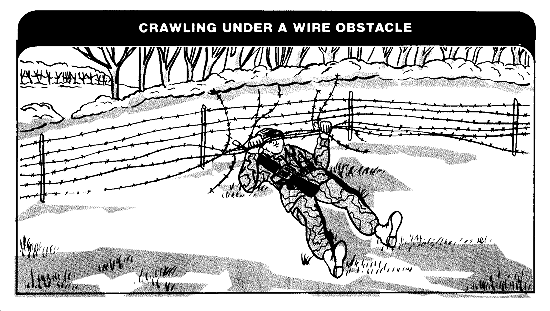
To cross over a wire obstacle:
-
Stay crouched down low.
-
Feel and look for tripwires and mines.
-
Grasp the first wire strand lightly, and cautiously lift one leg over the
wire.
-
Lower your foot to the ground.
-
Lift your other foot over the wire and lower it to the ground.
-
Release the wire and feel for the next strand.
-
To speed up a crossing, put boards or grass mats over the wire and cross
on them.
USING A BANGALORE TORPEDO
A bangalore torpedo comes in a kit that has 10 torpedo sections, 10
connecting sleeves, and 1 nose sleeve. Use only the number of torpedo sections
and connecting sleeves needed.
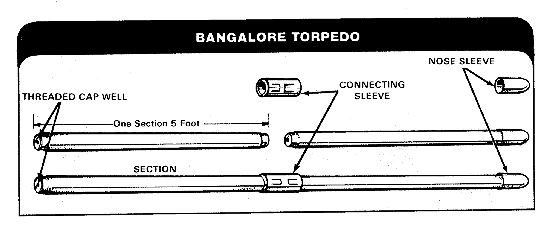
All torpedo sections have a threaded cap well at each end so that they may be
assembled in any order. Use the connecting sleeves to connect the torpedo
sections together. To prevent early detonation of the entire bangalore torpedo
if you hit a mine while pushing it through the obstacle, attach an improvised
(wooden) torpedo section to its end. That section can be made out of any wooden
pole or stick that is the size of a real torpedo section. Attach the nose sleeve
to the end of the wooden section.
After the bangalore torpedo has been assembled and pushed through the
obstacle, prime it with either an electric or nonelectric firing system (app B).
Once the bangalore torpedo has been fired, use wire cutters to cut away any
wire not cut by the explosion.
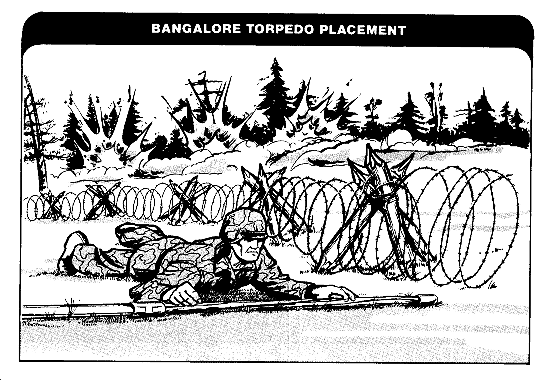
|
|
Approved for public release;
Distribution is unlimited.
The listing of any non-Federal product in this CD is not an endorsement of the
product itself, but simply an acknowledgement of the source.
Bureau of Medicine and Surgery
Department of the Navy
2300 E Street NW
Washington, D.C
20372-5300 |
Operational Medicine
Health Care in Military Settings
CAPT Michael John Hughey, MC, USNR
NAVMED P-5139
January 1, 2001 |
United States Special Operations
Command
7701 Tampa Point Blvd.
MacDill AFB, Florida
33621-5323 |
*This web version is provided by
The Brookside Associates Medical Education Division. It contains
original contents from the official US Navy NAVMED P-5139, but has been
reformatted for web access and includes advertising and links that were not
present in the original version. This web version has not been approved by the
Department of the Navy or the Department of Defense. The presence of any
advertising on these pages does not constitute an endorsement of that product or
service by either the US Department of Defense or the Brookside Associates. The
Brookside Associates is a private organization, not affiliated with the United
States Department of Defense.
Contact Us · · Other
Brookside Products

|
|
Operational Medicine 2001
Contents
|

|











